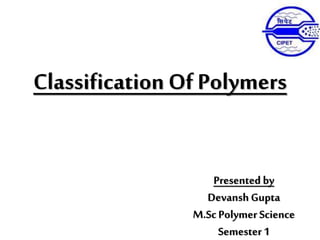
Classification Of Polymer On Different Basis
- 1. Classification Of Polymers Presented by Devansh Gupta M.ScPolymer Science Semester 1
- 2. Contents Some Basic Definitions Classification Of Polymers 1. By Origin 2. By Monomer 3. By Thermal Response 4. By Mode Of Formation 5. By Structure 6. By Application & Physical Properties 7. By Tacticity Reference
- 3. Definition The word ‘polymer’ comes from the Greek words poly (meaning ‘many’) and meros (meaning ‘parts’). Example: POLYETHYLENE = (ETHYLENE+ ETHYLENE+......)n Where n = 4,000 Polymers are very large molecules made when hundreds of monomers join together to form long chains.
- 4. Monomer The small individual repeating units/molecules are known as monomers(means single part). Imagine that a monomer can be represented by the letter A. Then a polymer made of that monomer would have the structure: -A-A-A-A-A-A-A-A-A-A-A-A-A-A-A-A-A-A-A-
- 5. Polymerization • The process by which the monomer molecules are linked to form a big polymer molecule is called ‘polymerization’. • Polymerization is a process of bonding monomer, or “single units” together through a variety of reaction mechanisms to form longer chains named Polymer • As important as polymers are, they exist with monomers, which are small, single molecules such as hydrocarbons and amino acids.
- 6. Classification Of Polymers 1. By Origin 2. By Monomer 3. By Thermal Response 4. By Mode Of Formation 5. By Structure 6. By Application & Physical Properties 7. By Tacticity
- 7. By Origin Natural Polymers Polymers which are isolated from natural materials are called as natural polymers. E.g. Silk, Wool, Natural rubber, Cellulose, Starch, Proteins etc.
- 9. Semisynthetic Polymers The polymers obtained by simple chemical treatment of natural polymers to improve their physical properties like lustrous nature, tensile strength are called semisynthetic polymers E.g. Cellulose acetate, Cellulose nitrate
- 10. Synthetic Polymers Polymers synthesized in laboratory from low molecular weight compounds, are called as, synthetic polymers. E.g. Nylon, Terylene, Polyethylene, Polystyrene, Synthetic rubber, Nylon, PVC, Bakelite, Teflon etc.
- 11. By Monomer Homo Polymers A polymer consist of identical monomers is called homo polymer. E.g. Polyethylene, PVC, Polypropylene, Nylon 6 Co Polymers A polymer consist of monomers of different chemical structure are called copolymers. E.g. Nylon 6,6
- 12. By Thermal Response Thermoplastic Polymers They are easily moulded in desired shapes by heating and subsequent cooling at room temperature. They are soft in hot and hard on coding. They my be linear or branched chain polymers. E.g. PE, PVC, PS, PP
- 13. Thermosetting Polymers This polymer is hard and infusible on heating. These are not soft on heating under pressure and they are not remolded. These are cross linked polymers and are not reused. E.g. Bakelite
- 14. By Mode Of Formation Addition Polymers The polymers formed by the addition of monomers repeatedly without removal of by products are called addition polymers. These polymers contains all the atoms of monomers hence their molecular weight are integral multiple of monomer unit. E.g. Teflon, Polyethylene, Polypropylene, PVC.
- 15. Condensation Polymers They are formed by the combination of two monomers by removal of small molecules like H2O, Alcohol or NH3. Their molecular mass is not the integral multiple of monomer units. They have ester and amide linkage in their molecules. E.g. Polyamides(Nylons), Polyesters(PET)
- 16. By Structure Linear Polymers In these polymers monomers are linked with each other and form a long straight chain. These chains has no any side chains. Their molecules are closely packed and have high density, tensile strength, and melting point. E.g. HDPE, Nylons
- 17. Branched Polymers They have a straight long chain with different side chains. Their molecules are irregularly packed hence they have low density, Tensile strength and melting point. E.g. LDPE, LLDPE
- 18. Cross-linked Polymer In these monomeric units are linked together to constitute a 3D network. The links involved are called cross links. They are hard, rigid .and brittle due to their network structure. E.g. Bakelite, Melamine, Formaldehyde resins, Vulcanized rubber
- 20. By Applications & Physical Properties Fibers If polymer is drawn into long filament like materiel whose length is at least 100 times it’s diameter, are said to be converted into fiber. They have high tensile strength because of high intermolecular attractive force like Hydrogen bonding. Highly crystalline. E.g. Nylon, Terylene.
- 21. Plastics Polymer is shaped into hard and tough utility articles by application of heat and pressure, is known as plastics. Here the intermolecular force between polymeric chains are intermediate between elastomers and fibers. They are partially crystalline. E.g. Polystyrene, PVC, PMMA
- 22. Elastomers They are solids with rubber like elastic properties. Here the polymeric chains are held together by the weakest intermolecular forces so they are highly amorphous in nature. These weak binding forces permit them to be stretched. E.g. Natural rubber, BUNA-S, BUNA-N, Vulcanised rubber
- 24. Resins Low molecular weight. Polymers which are used as adhesives, sealants etc., in a liquid form are described as liquid resins. E.g. Epoxy adhesives and polysulphides sealants.
- 25. ByTacticity Tacticity simply means deposition of side groups in space. The head to tail configuration in which the functional groups are all deposited on the same side of the chain, is called isotactic polymers. If the deposition of side groups is in alternating fashion, it is called synditactic polymers. If the deposition of side groups are at random around the main, it is called atactic polymers.
- 26. Other Parameters Of Classification By Crystallinity 1. Crystalline – Monomers arranged in ordered way. 2. Amorphous – Monomers arranged in random way. By Backbone Atom 1. Organic – Polymer Backbone is made-up of carbon atom. 2. Inorganic – Polymer Backbone is made-up of other atoms
- 27. References Polymer Science - Gowariker V. R., New age International Publishers Textbook of Polymer Science - Billmeyer F. W, Wiley India Publishers Advanced Polymer Chemistry – Manas Chanda Marcel Dekker INC.
